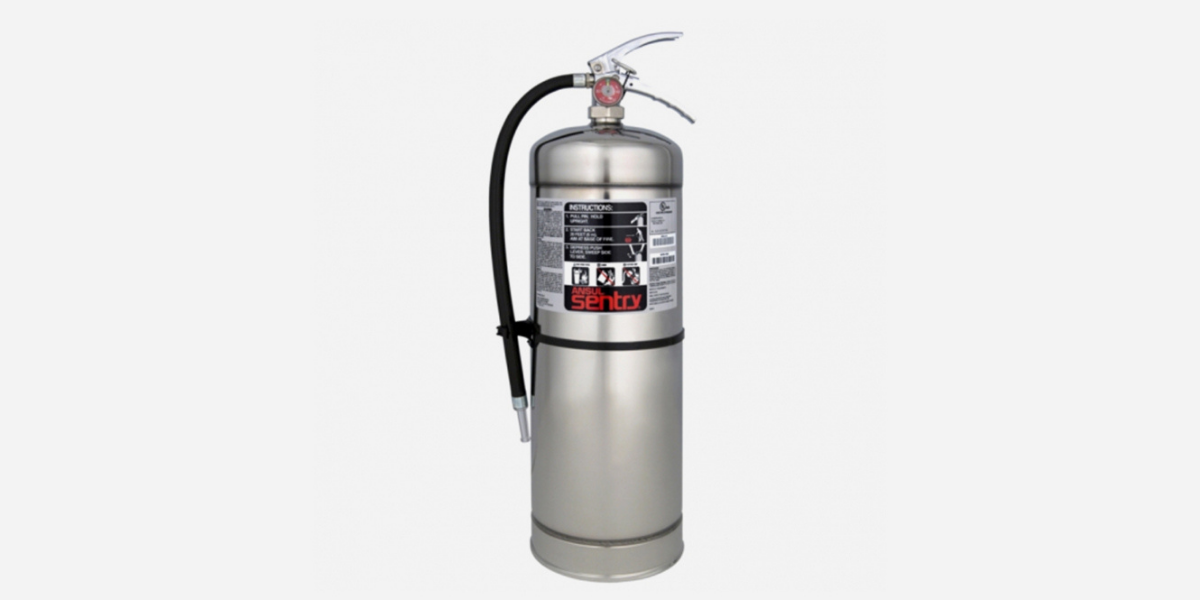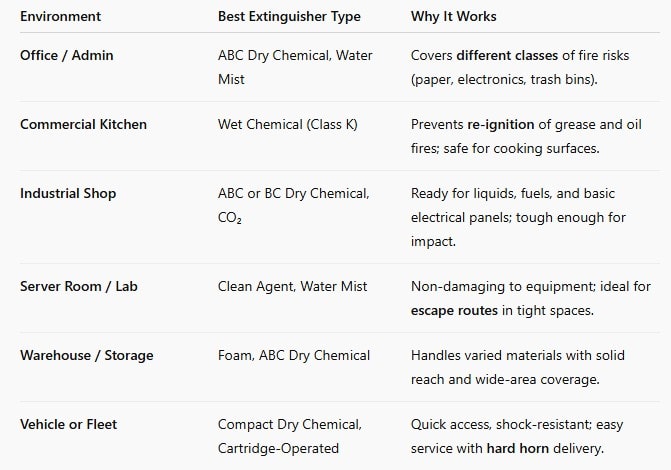Different Types of Extinguishers Explained (and What You Might Be Overlooking)

You see smoke. Instinct kicks in. Someone grabs the nearest extinguisher—the red cylinder that’s always hanging in the hallway—and aims.
But here’s the thing: what’s in that extinguisher matters just as much as having one at all. Depending on what’s burning, the wrong choice might do nothing—or make things worse.
There are different types of extinguishers for a reason, and they’re not all built the same. Some are designed to cool, others to smother, and a few work by interrupting chemical reactions altogether. And lately, there’s more to know: fast-flow models, clean agents, and mist-based units are bringing new tech into a space most people think hasn’t changed in decades.
If you haven’t looked at your fire extinguisher lineup in a while or if you just assumed one type fits all, it might be time to take a closer look.
Key Takeaways
- Fire extinguishers vary by type, and each is designed for a specific kind of fire—choosing the right one matters.
- Label codes like 2A:10B:C tell you exactly how much firepower an extinguisher delivers and what it's safe to use on.
- Matching extinguisher style to space and risk helps prevent re-ignition, reduce damage, and keep people safe.
The Classic Lineup
When people think about fire extinguishers, they often imagine a single, catch-all tool, but the truth is, fire extinguisher types are varied for a reason. Each is designed for specific burning materials, and newer options are expanding how and where they’re used.
Water & water mist
Still one of the most familiar options for ordinary combustibles like paper, wood, or cloth, water extinguishers cool the fire and remove heat from the triangle.
What’s new? Water mist models. These use a fine spray that’s non-conductive, making them safer to use near electrical equipment, which is a key advantage in settings like offices or hospital rooms where class C fires could also be a concern.
Foam
Foam extinguishers remain a frontline defense for class B fires—those involving flammable liquids like oil-based paints, solvents, or gasoline. They work by blanketing the liquid and separating it from oxygen.
Newer options include film-forming foams that reduce vapor and better prevent re-ignition, giving users extra control in active spill fires.
Dry chemical (ABC/BC)
Arguably the most versatile and common, dry chemical extinguishers can handle class A, B, and C fires. They're typically found in multipurpose portable fire extinguishers and are now available in fast-flow formats that discharge at a higher rate—critical for fighting flammable liquid fires in large or high-risk spaces.
They interrupt the chemical reaction that sustains combustion, making them effective across a range of environments.
Carbon dioxide (CO₂)
These use carbon dioxide to cool and displace oxygen, quickly smothering the flame. Since they leave no residue, CO₂ extinguishers are a smart choice for electrical fires in server rooms, confined spaces, or around sensitive electronic equipment. They also work well in food prep areas without leaving behind chemical cleanup.
Wet chemical
Specifically designed for cooking oil fires in commercial kitchens, wet chemical extinguishers cool the oil and form a soapy barrier to prevent re-ignition. These are essential for tackling class K fires, particularly those involving cooking appliances and animal oils.
Many newer models are class K extinguishers that also carry a class A rating—ideal for kitchen areas with mixed fire risks.
Dry powder (Class D)
These extinguishers are designed for combustible metals like magnesium, aluminum, or titanium, which can’t be extinguished using traditional agents. Found mostly in industrial or lab settings, dry powder isolates the fire and absorbs heat to smother it.
These are true specialists. They're not part of common extinguishers but are critical where class D fires are a possibility.
Clean agent & water mist sprays
These modern extinguishing agents are used in spaces where cleanup and damage are just as critical as fire suppression. Found in museums, data centers, or medical labs, clean agent extinguishers are non-conductive, leave no residue, and suppress fire quickly without harming equipment.
Along with water mist, they’re redefining what fire extinguisher classes can look like in sensitive or high-tech environments.
Choosing the Right Unit for Your Business
When it comes to types of fire extinguishers, the letters (A, B, C, etc.) tell you what kinds of fires a unit can handle, but that’s only part of the story. If you’ve ever seen a label like “2A:10B:C” and wondered what it actually means, we're here to bring some clarity.
Those numbers refer to firepower and coverage area. For instance, a 2A rating means the extinguisher is effective on a Class A fire comparable to what 2.5 gallons of water could handle. A 10B rating means it can cover 10 square feet of flammable liquid fire. Class C simply means it’s safe to use on energized electrical equipment, not that it suppresses electricity itself.
Match the tool to the environment
Beyond ratings, location and use case matter. In areas with ordinary combustible materials like paper, many plastics, or wood, you might opt for a basic ABC unit. But for kitchens, labs, or shops where fires involving flammable liquids or oils can break out, you’ll need to think about residue, speed of discharge, and delivery style.
Some extinguishers emit a solid stream, while others deliver a fine spray. The wrong delivery style could spread a grease fire or damage sensitive electronics. Choosing based on application helps ensure the extinguisher will safely extinguish the fire without making the situation worse.
It’s also important to follow the manufacturer's recommendations and ensure every unit on your premises has been tested by a nationally recognized testing laboratory and meets regular hydrostatic testing requirements. No matter how many extinguishers you have on-site, what matters most is that each one fits its space and is ready for immediate use when it counts.
Swap vs. Service: Keeping Units in Top Shape
Not all fire extinguishers are built the same on the inside. While they may look similar on the wall, some are stored-pressure units (the most common type), and others are cartridge-operated, which means each has different service expectations.
Stored-pressure extinguishers keep the agent and propellant sealed in a single chamber, meaning they’re always pressurized and ready. These are found in most fire extinguishers across offices and commercial spaces.
Cartridge-operated models, on the other hand, activate pressure only when triggered, making them easier to inspect, recharge, and maintain on-site with less downtime. That’s especially useful in environments like industrial shops or where class B extinguishers are deployed near chemicals or vegetable oils.
Service needs depend on the different extinguishing agents inside
For example, carbon dioxide extinguishers need precise weight checks since they don’t show pressure on a gauge. Clean agent models often require specific environmental conditions to maintain their cooling effect and safe use near electrically conductive equipment.
Dry chemical and dry powder units have different timelines for internal maintenance and discharge testing, especially after use on small fires or incidents where re-ignition is possible.
From a compliance standpoint, routine care matters. Fire codes, like those followed by your local fire department, require monthly visual inspections, annual professional servicing, and hydrostatic testing at manufacturer-recommended intervals. It's making sure the extinguisher you reach for works when the alarm sounds, and there’s no time to double-check the label.
Quick Decisions at a Glance
When it’s time to use a fire extinguisher, there’s no room for hesitation. The key is having the right one in the right place—ready for the risks that space actually presents. Here’s a simplified reference to help match common environments with the most practical extinguisher types.

No matter the setting, fire extinguishers vary for a reason. Smart placement based on activity and materials is what keeps a fire alarm from turning into a full-scale emergency.
Conclusion
Choosing the right extinguisher is understanding what kind of fire you’re preparing for. Matching the right tool to the right risk gives you faster response, less damage, and better protection overall.
And with today’s range of extinguisher options, smart choices don’t just keep people safe—they help you spend wisely, stay compliant, and stay ready.
Ready to Rethink Your Extinguishers?
Outdated, mismatched, or poorly placed units can leave big gaps in your fire safety plan. Swartz Fire & Safety will help you evaluate every space, choose the right extinguishers for the risks, and make sure they’re inspected, ready, and easy to use when it matters most.
Let’s make sure your fire protection works as hard as you do. Contact us today for expert help that fits your facility.
Frequently Asked Questions
What are the 4 types of fire extinguishers?
The four main types are water, foam, dry chemical, and carbon dioxide. Each works best on different fire classes based on the burning material.
What are the 3 most common extinguishers?
ABC dry chemical, CO₂, and water mist are among the most widely used due to their broad coverage and versatility.
What are ABCD fire extinguishers?
These are extinguishers rated for all four major fire classes: A (ordinary combustibles), B (flammable liquids), C (electrical), and D (combustible metals). However, it’s rare to find one that safely covers all four—Class D often requires a specialized unit.
Which is better, the ABC or the CO2 fire extinguisher?
It depends on the hazard. ABC extinguishers are more versatile for general use, but CO₂ is better for electronics and areas where no residue is critical.


